

Monday, 1st JULY 2002 JUST DESERTS! | |
| featuring: THE MUMMY (1932) Karloff's second major film appearance was in a Gothic fantasy in the Germanic style. He plays a 3000 year old mummy accidentally brought back to life. After 3,700 years, a British Museum field expedition in Egypt discovers the mummy of ancient Egyptian prince Imhotep, who was condemned and buried alive for sacrilege. Also found in the tomb is the Scroll of Thoth, which can bring the dead back to life. A young and naïve member of the expedition reads the scroll and thus unwillingly brings Imhotep back to life. Finally alive again, Im-Ho-Tep singlemindedly begins to search for his long lost love.It takes years for him to find a trace,but one day, almost by accident, he meets Helen Grosvenor (Zita Johann) and immediately senses that she is the reincarnation of Anck-es-an-Amon, the woman he had loved. Now Im-Ho-Tep has only one goal: to immortalize his love, and he will kill anyone who dares to step in his way. “The Mummy” was designed as a vehicle for Boris Karloff (celebrating a major success with “Frankenstein” at the time.) The filmmakers, aware that they couldn’t use the same recipe, instead created a different kind of suspense. William Balderston, who had already adapted screenplays for “Dracula” & “Frankenstein” was brought in to work on “The Mummy”. The result is a script with an ominous, brooding atmosphere and strong parallels to his work on “Dracula”. It is the subtlety of “The Mummy”, its understatement & breathtaking cinematography that make it a remarkable experience. Of all Mummy movies of the past, only this version can truly be considered a classic. |
 |
| Directorial debut of Karl Freund, veteran cameraman from Germany who had worked on numerous of F.W. Murnau’s films, Fritz Lang’s “Metropolis” and the genre classic “Der Golem”, and also served as cameraman on Tod Brownings “Dracula”. Not only is the photography breathtaking, the way Freund unfolds the story makes it a genre highlight. The best example of the remarkably restrained approach is the resurrection scene at the beginning. We do not even see Boris Karloff’s full-body make-up for which he endured endless hours in the make-up chair. We simply see a close-up of his head as he slowly opens his eyes. Next, we see the Mummy’s hand demanding the scroll, and then the loose ends of his bandages being dragged out the door. It is the slowness of this scene that makes it so effective. It is not known whether the decision to develop the film’s opening like this was ultimately made by Balderston or Freund. | 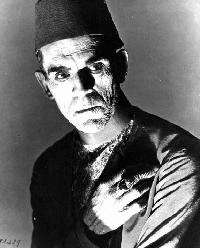 |
| Other memorable scenes are found when the camera prowls through the empty museum at night. Obviously Karl Freund’s background as a cameraman led to many of the film’s creative decisions.As a result, “The Mummy” is the most visual and poetic of classic monster movies, and the least horrific one. At its heart, this is a romantic love story about eternal suffering and the liberation from it. Ultimately it is Boris Karloff’s dignified portrayal of Im-Ho-Tep/Ardath Bey that catches your attention. Very different from the shambling creature he is famous for, his performance in “The Mummy” is as subtle as it is deep. His mannerisms and sonorous voice truly make you believe that he is man who has crossed time and worlds. There is not the slightest hint of agitation in his play, a calculating antagonist who is a menace to anyone, without displaying open hostility. The make-up is as stunning as the one in “Frankenstein”, and although mostly overlooked, it is the make-up of the un-mummified Karloff that is most remarkable. The highly effective extreme close-up while he uses his telepathic powers to kill people is a haunting image. Dramatic shadows make him look haggard, yet the fire in is eyes shows us his uncanny power. From the story by Nina Wilcox Putnam & Richard Schayer. STILLS...... WAVs: THEME ...... CURSE ...... MAD LAUGH Prod Co: Universal Pictures. Dir: Karl Freund. Prod: Carl Laemmle. Script:John L. Balderston. Photographer: Charles Stumar. Cast: Boris Karloff, Zita Johann, Arthur Byron. 73 min. NFVLS. | 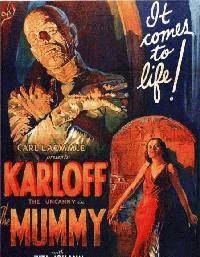 |
| EXOTIC EGYPT (195?) A travelogue on Egypt including scenes of camel trains, street-sellers, markets, statues, tombs, pyramids and the sphinx. Prod Co: Castle Films. 7 mins. ALC. THE PALACE OF THE ARABIAN NIGHTS (1905) A fantasy by Georges Méliès; one of his largest and most elaborate films, with a variety of tableaux and trick effects. Features a sorceror, a genie, a dragon, ghosts, stone monsters, an enchanted sword and a battle between living skeletons and swordsmen. All very RAY HARRYHAUSEN. Dir: Georges Méliès. 14 mins. NFVLS. |
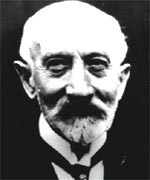 |
|
FELIX in ARABIANTICS (1928) Felix is transported to Arabia by a magic carpet. He trades the carpet for a bag of jewels which are promptly stolen. In pursuit of the jewels Felix finds himself in a harem. Prod: Pat Sullivan. Dir: Otto Messmer. 7 mins. NFVLS. |
 |
| I DREAM OF JEANNIE (1965) Episode: “PERMANENT HOUSE GUEST.” "I will go. You may keep the elephant!" - Jeannie I DREAM OF JEANNIE ep. Jeannie complains that her master Tony never asks for anything big, like a yacht. After coaxing him into allowing her to blink him up 'just one big thing', Tony closes his eyes and is rewarded with an elephant in his bedroom. Dr. Bellows arrives, and Tony explains he's just keeping it for a friend. Jeannie replaces the elephant with a toy poodle. When Bellows returns with General Paterson, he finds it hard to explain what happened to the elephant. Later Bellows tells Tony he is moving in with him to find out what is going on because Peterson thinks he is losing his mind. Doctor Bellows moves in and becomes convinced Tony's house is haunted after a series of nerve wracking experiences involving Jeannie's magic and Tony's "housekeeper", a fat Persian with a lady's (Jeannie's) voice. Tony tells Roger that if he can figure out a way of getting Jeannie's bottle out of the house, he will entrust her to his care until Bellows leaves. Before he can do so, Jeannie agrees to get rid of Bellows. He leaves, telling Tony he wouldn't stay another night. Roger arrives to pick up Jeannie. He has a long list of things he wants Jeannie to produce for him, ending with a maid. Jeannie blinks. Agnes, a hard-bitten female in a maid's uniform appears and lets Roger know who is going to be boss in this house. Season One(B/W)#24 .......... DETAILS:.......... STORYBOARD: Prod. SIDNEY SHELDON. Dir Hal Cooper/Claudio Guzman. Wr. SIDNEY SHELDON. Mus. NELSON RIDDLE. CAST: BARBARA EDEN, LARRY HAGMAN, Bill Daily, Hayden Rorke and Barton MacLane. 25 mins. NFVLS. |
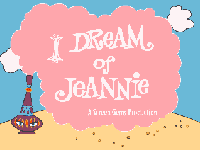 
|
| SAHARA HARE (1955) Wrong-way Bugs Bunny is tunneling to Miami Beach but reaches the Sahara Desert instead. After getting "footy prints" all over the Sahara Desert, Bugs rouses the ire of short-tempered Sheik Riff Raff Sam, bedsheeted bandit with towel dispensing head-dress (riding on an un-whoa-able bump-backed camel). Sam chases Bugs into a nearby Foreign Legion outpost, where he tries unsuccesfully to get in. Guest appearance by Daffy Duck. Bugs Bunny: Eh, what's up Doc? You with the sideshow around here? Yosemite Sam: I'm no Doc, ya flea-bitten varmint! I'm Riff-Raff Sam, the riffiest riff that ever riffed a raft! Bugs Bunny: Your slip is showing. IMAGES Prod Co: Warner Brothers. Dir:Friz Freleng. Script:Warren Foster. Animators: Gerry Chiniquy,Ted Bonnicksen, Arthur Davis. 7 min |
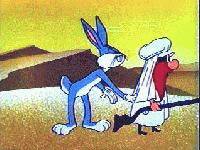 |
| THE SHEIK OF ARABY (1942) Kooky, novelty set-piece has wacky, eye-rolling, hookah-smoking "Sheik"' s toy train-set run right off the tracks. A novelty-band standby for years, with a taste of classical music in the intro, hinting at Spike's future ambitions. A SPIKE JONES & HIS CITY-SLICKERS "Jazz Soundie", released by Official Films. Wr. (1921): Harry Smith, Francis Wheeler, Ted Snyder . Vocal Refrain: Del Porter & Carl Grayson, Willie Spicer at the Hiccuphone. 2:23 mins. |
 |
| MORE SPLODGY INFO | |
| BACK TO THE VAULT | |
| SPLODGE! HOMEPAGE VAULT | |